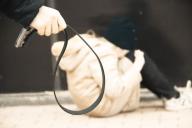Training and raising dogs makes them happy and causes fewer problems.
It also allows caregivers to sleep well.
We really like the idea that it would be nice to have a dog, many even dream about it since childhood, and having already acquired a friend in our home, we must remember our responsibilities towards them.

The owner must take good care of both the physical and mental health of their dog. In addition to proper nutrition, veterinary care and regular vaccinations, our dog also needs a lot of time and attention.
It is a continuous process of training and education for both the handler and the dog to create a comfortable daily life for both parties and to create a balanced bond between dog and owner.
Setting boundaries
When we have our own dog, we usually do everything together. From sleeping together, cooking, to watching TV.
We share everything with our dog, thus creating a bond with him. However, we should not show the dog that he is the center of attention all the time.
We should have specific time together where we play with the dog and focus mainly on him. Maintaining a healthy distance can also prevent separation anxiety from developing.
Where is the dog bed
It may seem obvious, but one of the first steps when you have a dog is to create a space for it to be its own.
For dogs living in a house or apartment, this could be a blanket, bed or bed. For dogs that sleep outside, the best option would be a suitable kennel.
Sometimes we may place more importance on the appearance of a den than its location, but sleeping in a colorful bed or Indian tipi will not make much difference to your dog. It is the correct position of the bed that is most important from a dog's point of view.
Dogs need more sleep than humans, so choose your sleeping place wisely. Constantly walking your dog will wake him up and prevent him from getting any rest.
Constant fatigue, the dog will be less inclined to learn and its behavior may become unpredictable or nervous. If we find a suitable place for our dog's den, we should not change it.
Establish a daily routine
We hear a lot about how routines can make our daily lives easier, and the same applies to dogs. A well-balanced routine is extremely important for our dog’s mental health.
If possible, feeding and walking should occur at the same time every day so that the dog knows what will happen during the day.
Of course, the point is not that the dog has breakfast at 6.52 every day, but that the food should be at about the same time of day.
Routine is especially important with insecure dogs. Knowing what to expect each day will increase their confidence. Not being surprised by new situations will help them progress much faster.
Time spent together and parenting
One of the many benefits of having a dog is that we get to spend time together. We enjoy watching sunsets together, and playing in the park is also a great way to clear our minds after a hard day at work.
As part of your daily or weekly routine, plan shorter and longer walks or trips to suit your needs and the needs of your dog.
A dog that is not tired enough can easily redirect his excess energy into destroying things around the house, and other behavioral problems can also arise.
Physical activity should go hand in hand with mental effort. A good way to improve our dog's skills, whether it is obedience training, is to find a good trainer or school.
Whether we use a personal trainer or go to a dog school with our friend, with proper training we will not only have an obedient dog, but also one that is motivated and satisfied.
Training requires a lot of concentration and thinking from our dog, so at the end of the lesson the dog will be tired, but at the same time happy. The trainer must also select an individual training program for our dog, depending on its temperament and skills.
Clear commands are the key to success
As with humans, communication is the basis of the relationship with the dog owner. Dogs do not understand our language, but they are very good observers and pay attention to even the smallest details, whether intentional or even unintentional, such as simple hand movements.
So if you want to tell your dog that you are not happy with the way your living room has been rearranged, despite the big innocent eyes, you need to clearly express your displeasure.
Words, tone, gestures and facial expressions must be the same when conveying a certain message. The same goes for training: it may be cute when your dog gives a paw instead of lying down, but we must remember that in such situations we cannot smile and pet him, as this is misleading to our dog. We need to understand the dog's language and be understood in it.
Remember a small nuance that will help you in communicating with your dog. Do not repeat the command many times, repeat it a maximum of two times. Otherwise, the dog will learn that the task can only be performed after the next command.
Consistency above all else
All the above recommendations are useless if we are not consistent.
At first it may seem difficult to implement all these rules, but after a while everything will become natural. Of course, it takes a lot of our energy, but it is worth it!
Earlier we wrote about which indoor flowers are dangerous for cats and dogs.








